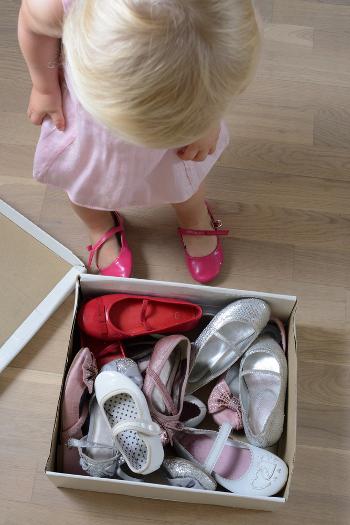Finding your shoes and socks
Duration/age

Quick! It’s time to go. We will be late for school. But where are your shoes and socks?
Encouraging your child to find their shoes and socks helps them to develop listening and navigation skills.
Talk to your child about where their shoes and socks might be. Is there a special place where all of the shoes are kept?
Your shoes are by the front door. We took them off before we came inside.
The questions you ask might change from day to day. Does your child wear the same shoes every day? Do they get to pick what shoes and socks they wear? Are you doing something special that your child needs particular shoes for?
It is dancing night. You need to find your pink dancing shoes.
Talk to your child about the weather and the different shoes they need for different situations. Are the rubber boots kept in the same place as the sandals?
We will have to find the rubber boots so we can go fishing. They are kept in the shed.
Materials you will need
- Shoes
- Socks
Alternative tools
- Rubber boots
- Ugg boots
- Tights
- Thongs
- Slippers
Skills this activity improves
Why does this matter?
Working with your child to find their shoes and socks is a wonderful opportunity for your child to hear and follow directions. When you ask your child questions they are practising listening and responding to a question. They are developing thinking and problem-solving skills.
As they listen to your instructions they are hearing language and directions involving position and location. Developing good listening skills will help your child to know what to do and where to go.
“The green socks are under the bed”.
“The rubber boots are outside by the back door but your socks are inside on the couch.”
What does this lead to?
Developing language skills, including listening and responding, helps children to develop new words and language. It will help them to hear how sentences or questions are put together.
By listening then responding, your child hears how you talk and has the opportunity to try and respond using similar words and sentence structures. It is by practising with an adult - and hearing different styles of language - that children develop a rich expanded vocabulary. As your child’s language expands, the number of words they use in a sentence will also expand.
Language to use
- Position, location, inside, outside
- Under, in, on top, next to, behind
- Sandals, boots, thongs, joggers, sneakers, shoes
Questions to use
- Are all the shoes by the front door?
- Do you wear the same shoes in winter and summer?
- Can you wear different shoes at the same time?
Useful tips
Remember to talk to your child in your home language.
More ideas
- You can practice listening skills by playing Simon Says.
- Go on a treasure hunt. Your child can listen to and follow instructions to find the next clue.
Variation by age
Birth to two year olds
- Play songs that encourage your child to listen and follow the actions.
- Sort a basket of socks, finding the matching pairs.
Three to five year olds
- Play songs that encourage your child to listen and follow directions.
- Tap stones or sticks together. Encourage your child to move to the speed of the rhyme.
- Take photos of different shoes and socks and use them to play matching games.
Questions to ask
- Whose socks are these?
- Is this a big sock or a little sock?
- Where do the socks go?
Questions to ask
- Do all shoes look the same?
- Is the music playing fast or slow?


